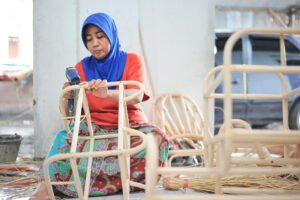Before the rattan export policy was implemented in 1986, many stems were harvested commercially to be shipped to Singapore, Hong Kong, Japan, America and European countries. At that time, Indonesia was the world’s largest rattan-producing country, although the national processing industry had not yet developed.
Then, after the issuance of the Decree of the Minister of Trade No. 274/KP/X/1986 concerning the ban on the export of raw rattan materials, the national rattan processing industry has experienced rapid development, from 20 companies to 300 companies.
Restrictions on exports from Indonesia to the world market have a negative impact on rattan-producing countries that do not have supervision. As a result, these countries lose their natural forest reserves.
An example is the rattan processing industry in Taiwan and Europe that relies on raw material supplies from Indonesia, many of which have gone bankrupt and shifted their business to Indonesia, especially in the Cirebon area.
In a further development, the ban on the export of rattan raw materials was reopened in 2005, with the issuance of the Decree of the Minister of Trade No. 12/M-DAG/PER/6/2005 concerning Rattan Export Provisions. This decree provides obstacles to the national processing industry.
The impact is increased unemployment, bad credit, reduced foreign exchange earnings and decreased contribution of the national rattan processing industry in the formation of GDP. On the other hand, competing countries such as China, Taiwan and Italy have again experienced quite rapid development.
To overcome this problem, several actions are needed, namely:
1. Improving market intelligence capabilities, as well as optimizing the functions of Atperindag and diplomatic representatives, actively participating in rattan product exhibitions abroad.
2. Review of Rattan Export Provisions in the Regulation of the Minister of Trade No. 12/M-DAG/PER/6/2005, to ensure the sustainability of the supply of rattan raw materials in the country, as well as to increase the competitiveness of finished goods products abroad.
In 2007, the Rattan Furniture Products and Rattan Crafts Exhibition was held in Indonesia as an effort to introduce, promote and market products and designs to the international world. The exhibition was attended by various producers in Indonesia who are members of ASMIN and AMKRI for the sake of the rise and development of the country’s rattan furniture industry.
Reference : https://rimbakita.com/ratan/

0 Comments